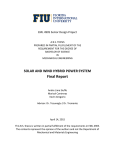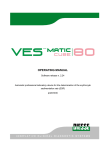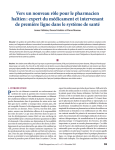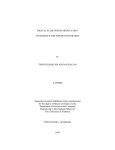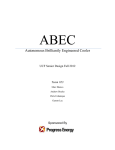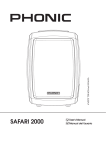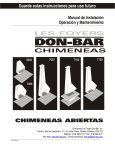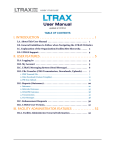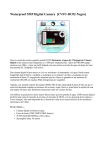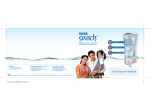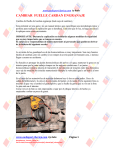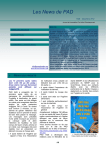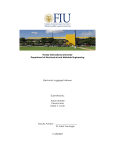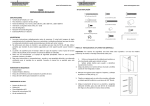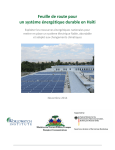Download SD Team 04: Solar-Powered Water Filtration System, William Boga
Transcript
EML 4905 Senior Design Project A B.S. THESIS PREPARED IN PARTIAL FULFILLMENT OF THE REQUIREMENT FOR THE DEGREE OF BACHELOR OF SCIENCE IN MECHANICAL ENGINEERING Solar Powered Water Filtration Final Report William Boga Alain Cobos Davindra Pooran Advisor: Professor Sabri Tosunoglu November 22, 2015 This B.S. thesis is written in partial fulfillment of the requirements in EML 4905. The contents represent the opinion of the authors and not the Department of Mechanical and Materials Engineering. Ethics Statement and Signatures The work submitted in this B.S. thesis is solely prepared by a team consisting of William Boga, Alain Cobos, and Davindra Pooran and it is original. Excerpts from others’ work have been clearly identified, their work acknowledged within the text and listed in the list of references. All of the engineering drawings, computer programs, formulations, design work, prototype development and testing reported in this document are also original and prepared by the same team of students. William Boga Alain Cobos Dr. Sabri Tosunoglu ii Davindra Pooran Table of Contents Solar Powered Water Filtration ................................................................................................................. i Ethics Statement and Signatures ............................................................................................................... ii Table of Contents ....................................................................................................................................... iii List of Figures............................................................................................................................................. vi List of Tables ............................................................................................................................................ viii Abstract........................................................................................................................................................ 1 1. Introduction ............................................................................................................................................. 2 1.1 Problem Statement............................................................................................................................ 2 1.2 Motivation.......................................................................................................................................... 2 1.3 Literature Survey .............................................................................................................................. 2 1.4 Survey of Related Standards ............................................................................................................ 3 2. Project Formulation ................................................................................................................................ 5 2.1 Overview ............................................................................................................................................ 5 2.2 Objectives........................................................................................................................................... 5 2.3 Design Specifications ........................................................................................................................ 5 2.4 Global Design .................................................................................................................................... 6 3. Design Alternatives ................................................................................................................................. 8 3.1 Overview of Conceptual Designs ..................................................................................................... 8 3.2 Centrifugal Pump............................................................................................................................ 11 3.3 Design Alternatives ......................................................................................................................... 13 3.3.1 Design Alternative 1 ................................................................................................................. 13 3.3.2 Design Alternative 2 ................................................................................................................. 13 3.3.3 Design Alternative 3 ................................................................................................................. 14 3.4 Proposed Design .............................................................................................................................. 15 4. Project Management ............................................................................................................................. 17 4.1 Workload Breakdown .................................................................................................................... 17 4.2 Gantt Chart ..................................................................................................................................... 17 4.3 Breakdown of Responsibilities among Team Members .............................................................. 18 5. Engineering Design and Analysis ........................................................................................................ 19 5.1 Overview .......................................................................................................................................... 19 5.2 Essential Components ..................................................................................................................... 20 iii 5.2.1 Solar Panel ................................................................................................................................ 21 5.2.2 Battery....................................................................................................................................... 22 5.2.3 Pump ......................................................................................................................................... 22 5.2.4 Filter .......................................................................................................................................... 23 5.3 Stress Analysis ................................................................................................................................. 24 5.3.1 Stress Simulation of Impeller 1 ............................................................................................... 24 5.3.2 Stress Simulation of Impeller 2 ............................................................................................... 26 5.3.3 Stress Simulation of Impeller 3 ............................................................................................... 28 5.4 Material Selection ........................................................................................................................... 30 5.5 Component Selection ...................................................................................................................... 32 5.5.1 Flow Simulation of Impeller 1................................................................................................. 33 5.5.2 Flow Simulation of Impeller 2................................................................................................. 34 5.5.3 Flow Simulation of Impeller 3................................................................................................. 35 5.5.4 Flow Simulation Results .......................................................................................................... 36 5.6 Design Overview.............................................................................................................................. 37 5.6.1 Pump Selection ......................................................................................................................... 38 5.7 Complete Cost Analysis .................................................................................................................. 46 6. Prototype Construction ........................................................................................................................ 47 6.1 Overview .......................................................................................................................................... 47 6.2 Description of Prototype ................................................................................................................. 47 6.3 Parts List .......................................................................................................................................... 48 6.4 Construction .................................................................................................................................... 54 6.4.1 Solar Panel Storage .................................................................................................................. 54 6.4.2 Assembly of the Impeller ......................................................................................................... 58 6.5 Prototype Cost Analysis ................................................................................................................. 60 7. Testing and Evaluation ......................................................................................................................... 62 7.1 Overview .......................................................................................................................................... 62 7.2 Design of Experiment ..................................................................................................................... 62 7.3 Test Results and Data ..................................................................................................................... 65 7.3.1 Original Impeller...................................................................................................................... 65 7.3.2 Impeller Design 1 ..................................................................................................................... 66 7.3.3 Impeller Design 2 ..................................................................................................................... 67 iv 7.3.4 Impeller Design 3 ..................................................................................................................... 68 7.4 Evaluation of Experiment Results ................................................................................................. 70 7.5 Discussion......................................................................................................................................... 72 8. Design Considerations .......................................................................................................................... 73 8.1 Health and Safety ............................................................................................................................ 73 8.2 Assembly and Disassembly............................................................................................................. 74 8.3 Manufacturability ........................................................................................................................... 74 8.4 Maintenance of the System............................................................................................................. 75 8.4.1 Regular Maintenance ............................................................................................................... 75 8.4.2 Major Maintenance.................................................................................................................. 75 8.5 Environmental Impact.................................................................................................................... 76 8.6 Economic Impact ............................................................................................................................ 76 9. Design Experience ................................................................................................................................. 77 9.1 Overview .......................................................................................................................................... 77 9.2 Standards Used in the Project........................................................................................................ 77 9.3 Contemporary Issues ...................................................................................................................... 77 9.4 Impact of Design in a Global and Societal Context ..................................................................... 78 9.5 Professional and Ethical Responsibility ........................................................................................ 78 10. Conclusion ........................................................................................................................................... 79 10.1 Conclusion and Discussion ........................................................................................................... 79 10.2 Evaluation of Integrated Global Design Aspects........................................................................ 80 10.3 Evaluation of Intangible Experiences ......................................................................................... 80 10.4 Commercialization Prospects of the Project............................................................................... 81 10.5 Future Work .................................................................................................................................. 81 Works Cited............................................................................................................................................... 82 Appendices ................................................................................................................................................. 84 Appendix A: User Manual ................................................................................................................... 84 v List of Figures Figure 1 Proposed Design ............................................................................................................................. 6 Figure 2 Circular Arc Method in SolidWorks .............................................................................................. 9 Figure 3 Point by Point Method .................................................................................................................. 10 Figure 4 Centrifugal Pump Internal Components [15] ............................................................................... 12 Figure 5 Design Alternative 1: Impeller 1 .................................................................................................. 13 Figure 6 Design Alternative 2: Impeller 2 .................................................................................................. 14 Figure 7 Design Alternative 3: Impeller 3 .................................................................................................. 15 Figure 8 Proposed Design Idea ................................................................................................................... 16 Figure 9 Proposed Design Components ...................................................................................................... 16 Figure 10 Photovoltaic Cells (Solar) [15] ................................................................................................... 21 Figure 11 Mesh View of Optimized Impeller 1 .......................................................................................... 24 Figure 12 Displacement of Impeller 1 at N=10,000RPM ........................................................................... 24 Figure 13 Von Mises Stress Impeller 1, N=10,000 RPM ........................................................................... 25 Figure 14 Strain of Impeller 1, N=10,000 RPM ......................................................................................... 25 Figure 15 Mesh View of Optimized Impeller 2 .......................................................................................... 26 Figure 16 Displacement of Impeller 2 at N=10,000RPM ........................................................................... 26 Figure 17 Von Mises Stress Impeller 2, N=10,000 RPM ........................................................................... 27 Figure 18 Strain of Impeller 2, N=10,000 RPM ......................................................................................... 27 Figure 19 Mesh View of Impeller 3 ............................................................................................................ 28 Figure 20 Displacement of Impeller 3 at N=10,000RPM ........................................................................... 28 Figure 21 Von Mises Stress Impeller 3, N=10,000 RPM ........................................................................... 29 Figure 22 Strain of Impeller 3, N=10,000 RPM ......................................................................................... 29 Figure 23 Flow Trajectory - Velocity of Impeller 1 at N=10,000 RPM ..................................................... 33 Figure 24 Cut Plot - Pressure of Impeller 1 at N=10,000 RPM .................................................................. 33 Figure 25 Cut Plot - Velocity of Impeller 1 at N=10,000 RPM .................................................................. 33 Figure 26 Flow Trajectory - Velocity of Impeller 1 at N=10,000 RPM ..................................................... 33 Figure 27 Cut Plot - Pressure of Impeller 2 at N=10,000 RPM .................................................................. 34 Figure 28 Flow Trajectory - Pressure of Impeller 2 at N=10,000 RPM ..................................................... 34 Figure 29 Cut Plot - Velocity of Impeller 2 at N=10,000 RPM.................................................................. 34 Figure 30 Flow Trajectory - Velocity of Impeller 2 at N=10,000 RPM ..................................................... 34 Figure 31 Cut Plot - Pressure of Impeller 3 at N=10,000 RPM .................................................................. 35 Figure 32 Flow Trajectory - Pressure of Impeller 3 at N=10,000 RPM ..................................................... 35 Figure 33 Cut Plot - Velocity of Impeller 3 at N=10,000 RPM .................................................................. 35 Figure 34 Flow Trajectory - Velocity of Impeller 3 at N=10,000 RPM ..................................................... 35 Figure 35 Moody Diagram [16] .................................................................................................................. 41 Figure 36 Roughness Factor for Various Pipe Materials [16] .................................................................... 42 Figure 37 Loss Coefficients for Pipe Fittings, Inlet, Exits, and Elbows [16] ............................................. 43 Figure 38 Continue- Loss Coefficients for Pipe Fittings, Inlet, Exits, and Elbows [16] ............................ 44 Figure 39 Continue- Loss Coefficients for Pipe Fittings, Inlet, Exits, and Elbows [16] ............................ 45 Figure 40 Mobile Job Box Case [17] .......................................................................................................... 48 vi Figure 41 Solar DC Circulation Pump ........................................................................................................ 49 Figure 42 Solar Panel Explode View .......................................................................................................... 49 Figure 43 Solar Panel .................................................................................................................................. 50 Figure 44 12 Volts DC Battery ................................................................................................................... 51 Figure 45 1 Micro-Filter Component .......................................................................................................... 52 Figure 46 Renogy PWM Charge Controller ............................................................................................... 53 Figure 47 Voltage, Amperage and Power Indicator.................................................................................... 53 Figure 48 Acrylic Case for Electrical Components .................................................................................... 54 Figure 49 Solar Panel and Casing ............................................................................................................... 55 Figure 50 Solar Panel next to Casing .......................................................................................................... 56 Figure 51 Cutting of the Acrylic panel which protects the Solar Panel ...................................................... 56 Figure 52 Assembling Modification for Solar Panel Storage ..................................................................... 57 Figure 53 Completed Solar Panel Storage Modification ............................................................................ 57 Figure 54 Impeller - Magnetic Core Assembly........................................................................................... 58 Figure 55 Printed Impeller Prototypes ........................................................................................................ 59 Figure 56 Prototype Assembly Interior ....................................................................................................... 59 Figure 57 Fully Assembled Prototype ........................................................................................................ 60 Figure 58 Pump Ready for Testing ............................................................................................................. 64 Figure 59 Pump Testing Configuration, 18 feet ......................................................................................... 64 Figure 60 Original Impeller Performance Curve ........................................................................................ 65 Figure 61 Impeller Design 1, Performance Curve ...................................................................................... 66 Figure 62 Impeller Design 2, Performance Curve ...................................................................................... 67 Figure 63 Impeller Design 3, Performance Curve ...................................................................................... 68 Figure 64 Schematic Reference .................................................................................................................. 70 vii List of Tables Table 1 Values for Circular Arc Method ...................................................................................................... 9 Table 2 Values for Point by Point Method [14] .......................................................................................... 11 Table 3 Gantt chart...................................................................................................................................... 17 Table 4 Breakdown of Responsibilities ...................................................................................................... 18 Table 5 Static Analysis of Impellers N = 10,000 RPM .............................................................................. 29 Table 6 ABS Material Properties - Solidworks Material Library [14] ....................................................... 30 Table 7 Material Properties of ABS vs PLA [14] ....................................................................................... 31 Table 8 Flow Simulation Results ................................................................................................................ 36 Table 9 Complete Cost Analysis................................................................................................................. 46 Table 10 Prototype Cost Analysis............................................................................................................... 61 Table 11 Original Impeller, Testing Data ................................................................................................... 65 Table 12 Impeller Design 1, Testing Data .................................................................................................. 66 Table 13 Impeller Design 2, Testing Data .................................................................................................. 67 Table 14 Impeller Design 3, Testing Data .................................................................................................. 68 Table 15 Comparison Table of Design Efficiencies ................................................................................... 69 Table 16 Comparison of Original Impeller and Impeller #2....................................................................... 69 viii Abstract The proposed water filtration system is to be a solar powered system to allow for reusable clean energy that is plentiful in the regions where clean water is needed most. The system will be deployed in the island nation of Haiti where natural and economic disaster have left much of the countries inhabitants without reliable access to clean water. This situation gives rise to disease outbreaks as well as a general degradation of public health. With an initial prototype it is the goal to proliferate clean water to as many families as possible with a single prototype aimed as servicing a household of four to five individuals. 1 1. Introduction 1.1 Problem Statement Clean water is needed by all; it is a basic necessity that is required for a multitude of tasks including cooking, cleaning, and bathing. Using suboptimal water for any of these activities brings its own set of risks ranging from mild passing sickness to lifelong ailments or death. There are over 700 million people in the world faced with the problem of consistent access to clean water, 82% of whom live in rural areas [1]. 1.2 Motivation The opportunity of living in a developed country wherein water is both accessible and affordable may cause one to take for granted the hardships of those living outsides those comfortable bounds. For this reason it is important to extend those luxuries to as many as possible. A 2015 global risks report listed the water crisis as the number one global risk to society (as a measure of devastation) and as such it is imperative to be proactive about reducing the number of people affected by this crisis [2]. 1.3 Literature Survey The main components of the proposed solar powered water filtration system to be deployed in areas wherein water is not as plentiful as needed are the energy collecting component, the solar array, and the water retrieval component, the centrifugal pump. The latter of the two has its roots dating back to 15th century where it was a mud lifting machine that appeared in a 1475 treatise by Italian engineer Francesco di Giorgio Martini [3], however modern centrifugal pumps did not appear until they were constructed using straight vanes by Denis Papin in the late 1600s [4]. Further improvements were made by John Appold when he 2 made use of curved vanes, this resulted in an efficiency of 68% more than three times better than that of any previous centrifugal pump [5]. Solar panels have been gaining traction in their wide spread use since a more sustainable clean energy source is desirable to the current fossil fuel production. The ever present sun represents the largest energy source in the world and as such much research has been poured into discovering the most efficient ways of harnessing it. The photovoltaic effect, where voltage is created when a specific material is exposed to light, was first observed by the French physicist, A. E. Becquerel in 1839 [6]. This effect of having electrons ejected from the material and causing an increase in electric energy is the basis upon which solar cells are built. More than 100 years after Becquerel’s discovery, in 1941, Russel Ohl invented the first solar cell following the invention of the first transistor. The intervening years have resulted in an increase in efficiency of the cells made by companies, universities, and agencies spanning the globe including NASA and Volkswagon [7]. These increases in technology have allowed numerous organizations to adopt standards and practices to be used in conjunction with said technology to obtain results in a given field. 1.4 Survey of Related Standards The standards to be used in the design of a system for creating clean usable water are very important as they are something that can affect the well-being of an individual. The International Organization of Standardization (ISO) has many different standards pertaining to the design of centrifugal pumps ranging from noise minimization to specific pressure ratings. The standard to be used deals with the removal of water from sand and free floating particles from shallow or deep borewells, ISO 17613-1:2006 [8]. More important than the pump, in terms of human safety, are the standards use for the filtration system. The Centers for Disease Control 3 and Prevention recommend following the National Sanitation Foundation (NSF) 53 or 58 rated cyst reduction/removal filter to remove any non-viral organism. This is the best standard currently as there exists no filter capable of removing viral organisms [9]. 4 2. Project Formulation 2.1 Overview The basic tenant of the solar powered water purification system is to provide clean water in meaningful amounts to those in particular need. Areas that would most benefit from such a system would be those that perhaps have water, be it from a lake or well, but have little to no way to utilize the contents in a safe way. 2.2 Objectives The objectives of this system are to use an inexpensive renewable energy source in order to reduce harmful waste byproducts and minimize cost. The system will harness the relatively unlimited solar resource to power a pump that will clean an amount of water suitable for a small household of four to five persons. The goal is to pump and clean 400 gallons of water per day, averaging approximately 70 gallons per hour requiring a running time of six hours spread between ideal sunshine conditions and backup battery power. This amount is based upon the average consumption from an American family of four [10]. The average consumption per capita in Haiti is far below that of an individual in the United States, between roughly 8 and 15 gallons [11], resulting in a large surplus of water to be used or stored. Additionally, the original impeller from the centrifugal pump will be replaced by one of an original design which seeks to improve the flow rate by 5% and thus increase efficiency and decrease dependence on optimal sun conditions. 2.3 Design Specifications The water purification device will utilize several parts in an effort to achieve the desired effects. The peoples that the device is aimed at helping primarily reside in areas where sunshine is plentiful, as such a solar panel will be used to gather this abundant resource. In turn the panel will charge a battery so the system can run when there is no Sun, be it at night or cloudy and 5 stormy weather. The battery will power a pump that pulls the water from whence it resides up a hose, through a filtering mechanism, and deposits the freshly cleaned water in a reservoir. Figure 1 Proposed Design 2.4 Global Design The access to water is of particular importance when implementing a tool for cleaning said water. One individual may reside next to a suitable source, river or lake, whereas another may have to journey several hours to the same area to gather water. With that in mind it is important to design the system to not be cumbersome without sacrificing effectiveness. Another chief concern is ease of use. For instance, Haiti ranks amount the lowest in the Western hemisphere in formal education and has only a 55% literacy rate, well below the 90% of neighboring South American and Caribbean countries [12]. It is important to keep the complications of using this system to a minimum by reducing the design to a simple set-up usable by a variety of peoples with differing amounts of education and literacy. 6 It is also important to keep in mind the areas in which this sort of project will be undertaken and the sorts of impacts it may have on the local community. By providing water on a larger scale than what was once available local economies may be impacted, perhaps not large scale but impacted nonetheless. Increased water supply may lead to an agricultural upswing resulting in higher yielding crops, which as a result may lead to better nutrition or a surplus of material goods that may then be sold or traded for money or other necessities. This sort of chain reaction has the potential to raise the standard of living more so than originally thought. These sorts of changes are not limited to a particular region on the globe but rather any region where getting water is a feat in and of itself. The design also takes into consideration the lower incomes of the areas most affected by the lack of water. Often time’s places that lack water lack the means to purchase equipment that would help obtain that same water [13]. This design aims to be more appealing to those places by being produced at a much more affordable price that can be used by even the most poverty stricken areas in the world. 7 3. Design Alternatives 3.1 Overview of Conceptual Designs The driving force behind the main component within the pump is the impeller which generates a centrifugal force. In order to increase the efficiency of the system, save energy, and generate more output flow, optimization methods were implemented. Research has proven that the implementation of optimization methods upon impeller vane blades within a pump will yield greater pressure and overall flow within the pump. Although many optimization methods exist, the circular arc method as well and the point by point iteration make the most significant impact in regards to increased output velocity. The idea behind the circular arc method is to design the impeller in a manner in which the impeller is arbitrarily divided into a number of concentric rings between r1 and r2. The radius of arc (insert Rho), between r-band and r-ais which are obtained from the equation below. The computations for the values of rho for various rings and the radii of arc of the vane are shown below. 8 Figure 2 Circular Arc Method in SolidWorks Table 1 Values for Circular Arc Method The lengths for radius 1, radius 2, inlet angle, outlet angle and the radius of curvature are all represented in Table 1. The above values correlate to the creation of the vanes of the impeller, as their dimensions were taken into account for the arcs and inlet and outlet angles of the impeller. The second optimization method implemented is known as the point by point method. This method consists of generating coordinates which will be used to create the vane profile. 9 The point by point method was implemented within the impellers that have been both 3D printed and tested in the experimental trials. Figure 3 is a screenshot from the design of the impeller using the point by point optimization method. Figure 3 Point by Point Method In order to generate the data required for the vane definition the point by point method is tabulated with the below table to complete the process. Each point is created based on the following values which are used to find the desired radius and theta which directly correlate to the radius of the point and angle of the vane within the impeller. 10 Table 2 Values for Point by Point Method [14] 3.2 Centrifugal Pump The Centrifugal design uses a rotating impeller to draw water into the pump and pressurize the discharge flow. Centrifugal force is defined as the action that causes something, in this case water, to move away from the center of rotation. All centrifugal pumps use an impeller which is a rotating disk with a set of vanes coupled to a motor to produce the centrifugal force and a volute (which is the stationary housing in which the impeller rotates that also collects, discharges and circulates water entering the pump) to create the partial vacuum and discharge pressure necessary to move water through the casing. Most models of standard centrifugal pumps offer 2 to 4 inch range, with flows from 142 to 500 gallons per minute and heads in the range of 90 to 115 feet. At the heart of the centrifugal pump lies the impeller. Without the impeller centrifugal force could not be possible. As the impeller is the primary feature of the centrifugal pump it can be modified to better suit a specific application. Noting that a goal of 70 gallons per hour has been set, an impeller will be modified and validated with a future goal of testing the impeller for improved efficiency of the system. A modified impeller may yield improved energy efficiency 11 along with a greater gallon per hour output. The diagram below displays the bare bones of a centrifugal pump. Here you will see the vital components to this system like the impeller, volute, and vanes of the impeller, as well as the eye of the impeller, inlet, and outlet. Furthermore here we can pinpoint the location and basic makeup of the impeller which we will later modify for optimization purposes. Centrifugal pumps vary by multiple features, most importantly the driving force behind all centrifugal pumps is the impeller. The design of the impeller directly affects the operational condition of the head. Furthermore the vane profiles which lies upon the impeller can be constructed in numerous ways, based on the circular arc method. Figure 4 Centrifugal Pump Internal Components [15] 12 3.3 Design Alternatives 3.3.1 Design Alternative 1 Now that optimization methods have been set, the next goal was to design an impeller capable of increasing the solar powered pumps pressure and velocity. Thus impeller 1 was created as the first design alternative. The optimization method applied to impeller 1 is known as the circular arc method. The idea behind the circular arc method is to create a set number of arcs, and design the vanes of the impeller based on the radius of the preceding arc until the final arc is found. A conical addition to the top of the impeller was added for testing purposes in both the flow simulation and physical experimental trials. Figure 5 Design Alternative 1: Impeller 1 3.3.2 Design Alternative 2 As the design of impeller 1 fared very well in regards to the pressure and velocity generated in the flow simulation, a slight tweaking of impeller 1 was applied to make impeller 2. Impeller 2 again was created using the circular arc method. The tweak that differentiates impeller 1 from impeller 2 is that it does not contain a conical addition that exists on impeller 1. The idea behind removing the conical section is that impeller 2 will allow the flow of water to travel in between the vanes instead of restricting the flow in the conical section of the region. As a flow 13 simulation was conducted on both impeller 1 and impeller 2, using the same parameters for each impeller to ensure consistency in the trials, results yielded higher pressure and velocity for impeller 2 over impeller 1. Figure 6 Design Alternative 2: Impeller 2 3.3.3 Design Alternative 3 Even though the first 2 impellers were very similar in design and in regards to the stock impeller which the pump came with, impeller 3 was created using a different method. Impeller 3 was created with a varying plane method, as you can see a loft was applied to create the variance of planes. The idea behind impeller 3 is that the vane angles vary immensely and their expelling of fluid volume should be higher based on the design. With the completion of flow simulation, results will prove whether or not this method achieves its initial goal of moving fluid volume at a higher rate in comparison to the original pump. 14 Figure 7 Design Alternative 3: Impeller 3 3.4 Proposed Design The proposed system will adhere to the following system design: 1. The solar panel will capture energy to be stored into the designated flow battery [1]. 2. The energy stored in the battery will be used by the pump to retrieve water. 3. The pump will then send that water through the specified filter. 4. The filter will now send the filtrated water to the appropriate water storage tank. The positioning of the panel, battery, pump, piping, filter, and storage tank will be determined by the team after proper research has been conducted. These design elements will ensure maximum efficiency of the system. The solar panel will be strategically placed at the top of the system to ensure that the panel is at the fixed tilt angle which is variable depending on the latitude of the system. This change in location affects the angle of the panel with respect to the sun so optimization is required. The solar panel will transmit power to be stored in the battery via 4 gage wiring. Once that the battery is charged it will power the pump that is connected to the PVC pipe. The pump will send the water through the filtration device. Once that the water has 15 been pumped and filtered it will reach its final destination of the water storage tank. Figure 1 represents the conceptual final design that is planned to fulfil the objectives previously set forth. Figure 8 Proposed Design Idea Figure 9 Proposed Design Components 16 4. Project Management 4.1 Workload Breakdown The work listed in Table 3 will be divided evenly amongst one another thereby increasing the work that can be done in same amount of time when compared to if all members did everything together. 4.2 Gantt Chart As shown in Table 3 the Gantt chart represents the dates by which progress is planned to complete for specified tasks. The Gantt chart will serve as a guide to ensure project progress. Table 3 Gantt chart Description Jan, 2015 Feb, 2015 Mar, 2015 Apr, 2015 May, 2015 Jun, 2015 Jul, 2015 Aug, 2015 Sep, 2015 Oct, 2015 Nov, 2015 Dec, 2015 Research and Design Literature Survey Design Alternatives Modeling and Simulations Cost Analysis Part Acquisition Assembly Testing Prototype Test and Analysis Report 17 4.3 Breakdown of Responsibilities among Team Members Phase 1: Table 4 Breakdown of Responsibilities Phase 2: Phase 3: Phase 4: 18 5. Engineering Design and Analysis 5.1 Overview The design behind the Solar-Powered Water Filtration System relied heavily on 3 main components in the system. Those three components are the solar-powered pump, battery, and solar panel. As the battery and solar panel are concrete in their design, not much can be done to optimize or improve their performance, configuration, or design. Therefore leaving the solar powered pump as the final component and the driving force of the system. Once the solar-powered pump was recognized as the most important component within the system, the next step was to identify what could be done to optimize the pumps’ design, efficiency, and overall output. After research was conducted on optimization of centrifugal pumps, impeller optimization was found to make the biggest impact, once implemented accordingly. In order to optimize the impeller, multiple methods were implemented in the attempt to find the best design. Research yielded two methods that led to the creation of an impeller with overall increases in volume output, velocity, and pressure. The two methods that were implemented for optimization were the point by point method and the circular arc method. Although the optimization methods were realized, two tasks still remained. The first task was to find which optimized impeller truly had a better efficiency, output in flow, and overall better design. To prove that the optimized impeller was more capable than the original, Solidworks flow simulation was implemented to show the optimized impellers’ advantages over the original impeller. 19 By implementing Solidworks flow simulation, the advantages of optimization methods were clearly shown. Once the flow simulation results were compiled, it was obvious that the circular arc method was the optimization method of choice, as the results yielded from this simulation had the best overall marks in regards to velocity and pressure generated by the impeller. With the completion of Solidworks flow simulation, the next task was to recreate the optimized impeller for testing. The options for manufacturing the impeller were the following: Plastic Injection Molding, NC Manufacturing, and Rapid Prototyping. After reviewing the resources available for recreating a small plastic part, 3D printing was chosen as the most cost effective means of manufacturing. The 3D Printer chosen to recreate the optimized impeller was the XYZ Da Vince 1.0 AIO. The material chosen to print the 3D impeller was ABS Plastic Filament. This ABS Plastic material was chosen as it was more flexible, stronger, and has a higher temperature resistance in comparison to the PLA filament material alternative. Before testing the 3D printed optimized impeller, a Solidworks stress analysis of the optimized impeller was conducted in order to ensure the ABS material would hold up at the speeds and pressures it would be subjected to within the solar-powered pump. The results from the Solidworks stress analysis showed that at higher speeds the displacement of the impeller based on the material will still hold up during testing, further testing proved this to be true. 5.2 Essential Components The objective for this project is to deliver a product that can provide filtered water without maintenance problems while in use. Some of the major components that the system will 20 consist of include the following: A solar panel, a battery, water pump and filters able to remove the majority of pathogens and bacteria found in water. 5.2.1 Solar Panel Solar panels are devices that are made to harvest the energy provided by the sun and to convert this energy into electricity that can be used for many applications. The energy of the sun is considered one of the cleanest types of energy because it does not pollute the environment as fossil energy does. Recent strides have been made to reduce the use of fossil fuel as a main source of energy by expanding and improving the use of renewable energy. Solar panels are composed of a combination of photovoltaic cell which creates an electrical voltage when exposed to direct sunlight. Many of these photovoltaic cells are spread over a large surface area where they act as one to collect the solar energy. Solar energy has been growing worldwide as part of a global shift toward a future and safer environment free of pollution created by fossil fuels. The team will use solar panels as the main source of energy, however in order to provide an energy estimation for our system to work the following must be answered: Figure 10 Photovoltaic Cells (Solar) [15] 21 How much power is needed? Can the requirements be met using solar panels? For how long must the panels be used? A good source of information regarding solar panels is that they come with labels stating their maximum watts and voltages. For example if a solar panel is rated 100 watts at 12 volts, then it is being stated that it will produce a maximum of 100 watts per hour of sunlight. Normally the average of sunlight per day is estimated to be around 6 hours, so considering this average allows for a daily production of 600 watts. 5.2.2 Battery A battery is a device that is used to store electrical energy for later usage. It consists of three parts: an anode (-), a cathode (+), and the electrolyte. When a battery is fully charged there is a pressure difference of electrons between the anode and the cathode that normally is separated by the electrolyte. When a wire is connected from the terminals of the positive and the negative a closed circuit is created and electron flows from one side to the other until equilibrium is obtained. This motion of electron generates useful electricity for objects to operate. The purpose in using a battery to power the water filtration system is to make it portable, as small as possible, and also to provide energy at times when is not sunny. Batteries are measured in (A.H) or Amperage*Hours and can last a relatively long duration from a single charge depending on the amount of energy extracted. 5.2.3 Pump A pump is one of the main components of a system and its purpose is to move the fluid by mechanical actions. Some calculations need to take place in order to decide the pumping power that the system will be consuming by using Bernoulli’s formula. The desired pump will 22 need to meet the required performance, by being both light in weight and work in conjunction with the solar panel. Further analysis will be discussed later on as we move forward into the design characteristics of the required pump. 5.2.4 Filter The filter is another key element from the water filtration system. It is the one and only element that will be removing the undesirable microorganisms that are normally found in water. Filters are essential in this regard and are used in multiple applications. In the proposed situation there are many bacteria and viruses found in water sources than can cause illness or be life threating to humans. In developing regions such as Africa, Haiti, India bacteria’s in water are easily found because these countries have lack of resources for sanitation and even good education. Filters are rated based on micron filtration ratio, for example a 5 micron rated filter is better suited at removing microorganisms than a 20 micron rated filter as it is a smaller filter and performs better overall. As of today, it has been proven that filters with rating equals to 1 micron or less can be effective in removing 99.99% of pathogen regularly found on water. Nevertheless, as stated by the Center for Disease Control (CDC) filter are effective in removing pathogen and bacteria’s but does not removed viruses from water, which is why boiling is always recommended [9]. The objective is to find a filter that can meet such requirements of effectiveness on 99.99% removal of waterborne organisms. 23 5.3 Stress Analysis 5.3.1 Stress Simulation of Impeller 1 Figure 11 Mesh View of Optimized Impeller 1 Figure 12 Displacement of Impeller 1 at N=10,000RPM In order to ensure that each impeller can withstand the forces subjected upon them, a static simulation was conducted in SolidWorks. The goal of the simulation was to test and confirm that the impellers would not deform in a manner that would deem the results poor. During the configuration of each simulation the following parameters were used for simulation: the bottom of the impeller has a fixed geometry and the inner region has a centrifugal force of 10,000 RPM as this will correlate to the highest speed of the impeller with zero head applied to the pump. 24 Figure 13 Von Mises Stress Impeller 1, N=10,000 RPM Figure 14 Strain of Impeller 1, N=10,000 RPM 25 5.3.2 Stress Simulation of Impeller 2 Figure 15 Mesh View of Optimized Impeller 2 Figure 16 Displacement of Impeller 2 at N=10,000RPM The operational region of the solar-powered pump ranged from an RPM of 1,600 – 10,000 RPM. Although simulations could have been ran for each iteration within the mentioned range, the speed of most concern was the maximum that the pump is capable of which was 10,000 RPM. 26 Solidworks simulation is a very capable analysis tool which can run numerous studies depending on the analysis required by the user. The desired application for the stress analysis of an impeller was a static study to find the following values: Von Mises Stress, Displacement, and Strain. Once the desired values had been established, simulations were conducted to retrieve this data. Simulation reports were generated for all three impellers so that their individual qualities could be displayed. Figure 17 Von Mises Stress Impeller 2, N=10,000 RPM Figure 18 Strain of Impeller 2, N=10,000 RPM 27 5.3.3 Stress Simulation of Impeller 3 Figure 19 Mesh View of Impeller 3 Figure 20 Displacement of Impeller 3 at N=10,000RPM The static analysis table has been generated base off of the values retrieved from the simulation reports created by the Solidworks simulation workbench. The impeller that endured the highest stress, strain and displacement was impeller 2. Stress analysis proved to be useful in this experiment because it proved that the ABS-based impellers will be able to withstand the forces subjected to them in the actual testing of the experiment. 28 Table 5 Static Analysis of Impellers N = 10,000 RPM Figure 21 Von Mises Stress Impeller 3, N=10,000 RPM Figure 22 Strain of Impeller 3, N=10,000 RPM 29 5.4 Material Selection When using a 3D printer to create an object the options with regards to materials are limited as to what the printer is capable of using. In the instance that one uses the XYZ Da Vinci 1.0, the filament material options are the following: PLA (Polylactic acid or polylactide), or ABS (Acrylonitrile butadiene styrene). The PLA and ABS materials both have their drawbacks, neither is perfect for the experiments desired application. After researching both materials, ABS was selected as the filament of choice. The reason ABS was chosen over PLA was due to its’ cooling time, Rockwell hardness, and compressive strength. The petroleum based ABS was also chosen over the plant based PLA filament because PLA is not a selectable material in the Solidworks Material Library. In regards to Solidworks Simulation, material properties are absolutely necessary in the calculations of stress, strain and displacement. Under these circumstance the material properties of ABS were available under the plastic options inside of the Solidworks material library. Table 6 ABS Material Properties - Solidworks Material Library [14] The XYZ Da Vinci 1.0 can use both PLA and ABS filament to generate a 3D printed image. If a user is to go from one filament cartridge to another, the XYZ must be updated with 30 the type of material the user is attempting to print with. The XYZ must be updated because of the material property differences amongst both filaments. The printer is required to heat the extruder which lays the filament, to a higher temperature for ABS due to its higher melting point in comparison with PLA which has a significantly lower melting point. Table 7 Material Properties of ABS vs PLA [14] 31 5.5 Component Selection At the heart of the Solar-Powered Water Filtration System is the centrifugal pump. Within the pump the primary driving force with regards to the fluid volume that is moved is the centrifugal impeller. This centrifugal impeller has been optimized with the backwards curve circular arc method, and is also represented in design alternative 1, 2 and 3. In order to narrow down which design outperformed one another, Solidworks flow simulation was implemented as the analysis tool to realize which optimized centrifugal impeller was the most capable in regards to pressure and velocity. Focusing on the solar powered pump, the operational region of the pump ranges from 1,600 RPM to 10,000 RPM. The range of the operational pump indicates the following, lower RPM correlates to higher head length applied to the pump. For example the maximum operational head length the pump is capable of moving is 18 feet, therefore the speed of the impeller is 1,600 RPM here. The same can be said on the opposite end of the spectrum, the minimum operational head of the pump is 0 feet, and the speed of the impeller is 10,000 RPM here. In order to thoroughly evaluate the optimized centrifugal impellers, Solidworks flow simulations were conducted at the following rotational impeller speeds: 1,600 RPM, 5,800 RPM and 10,000 RPM. The speed of 5,800 RPM was chosen as it represents the midway point of the operational region of the pump, about 9 feet. As mentioned before three design alternatives were created and three Solidworks flow simulations were each ran at specified rotational impeller speed, altogether nine simulations were ran to properly evaluate the impellers at specific speed. In each of the flow simulations, data was collected with regards to pressure and velocity. The parameters that remained the same 32 throughout all flow simulations were the following: the inlet pressure, and the outlet volume flow. In order to retrieve all desired data, reports were generated by Solidworks for all nine iterations of flow simulation at specific speeds. 5.5.1 Flow Simulation of Impeller 1 Figure 24 Cut Plot - Pressure of Impeller 1 at N=10,000 RPM Figure 23 Flow Trajectory - Velocity of Impeller 1 at N=10,000 RPM Figure 25 Cut Plot - Velocity of Impeller 1 at N=10,000 RPM Figure 26 Flow Trajectory - Velocity of Impeller 1 at N=10,000 RPM Optimized impeller 1 was created from the design of optimized impeller 2, the main variance between the two impellers is the plastic ring in the center of the impeller. The goal 33 behind this flow simulation test was to see whether or not the ring would yield greater pressure and velocity in comparison to impeller 2. 5.5.2 Flow Simulation of Impeller 2 Figure 27 Cut Plot - Pressure of Impeller 2 at N=10,000 RPM Figure 28 Flow Trajectory - Pressure of Impeller 2 at N=10,000 RPM Figure 29 Cut Plot - Velocity of Impeller 2 at N=10,000 RPM Figure 30 Flow Trajectory - Velocity of Impeller 2 at N=10,000 RPM Optimized impeller 2 was created with the backward curve circular arc optimization method. The performance of this impeller was far beyond that of impeller 1. The flow 34 trajectories and cut plots generated by Solidworks illustrate the velocity and pressure differences between the two impellers. 5.5.3 Flow Simulation of Impeller 3 Figure 31 Cut Plot - Pressure of Impeller 3 at N=10,000 RPM Figure 32 Flow Trajectory - Pressure of Impeller 3 at N=10,000 RPM Figure 33 Cut Plot - Velocity of Impeller 3 at N=10,000 RPM Figure 34 Flow Trajectory - Velocity of Impeller 3 at N=10,000 RPM 35 Once each impeller had been evaluated at three specific speeds the results of each flow simulation could be compared with one another. Data with regards to pressure and velocity was retrieved from the nine flow simulations that were conducted by way of reports, which were generated by Solidworks. 5.5.4 Flow Simulation Results Table 8 Flow Simulation Results After reviewing each report and evaluating the results calculated by Solidworks, it was concluded that the optimization methods used in impeller 2 were most effective. Not only did impeller 2 generate the greatest overall velocity, but it was able to outperform impeller 1 and 3 at both 1,600 RPM and 5,800 RPM as well, deeming it the highest performing impeller. With the completion of research on optimization methods, stress analysis, material selection, and flow simulation applications, experimental testing results are required to validate the design and flow simulation values. Based upon the nine flow simulations that had been created, optimized impeller 2 stood out as generating the highest pressure and velocity based on the results yielded in the flow simulation reports. 36 In order to confirm that the Solidworks Flow Simulation is correct or not, experimental results are required for validation. Furthermore the results yielded by Solidworks are simply a guide as to what should be expected in the real experimental trials. The number of factors during the experimental trials are far greater than those of the flow simulation conducted in Solidworks, therefore the actual results will vary from the current theoretical results. Impeller 2 is projected to generate higher flow and lower efficiency based on its results from the Solidworks flow simulation reports. Although the manufacturing methods are not perfect, the experimental testing will prove how far off the calculations ran by Solidworks are. 5.6 Design Overview From an engineering point of view we must provide information and calculations related to the performance of the systems in order to meet our desired goal. As part of the analysis to obtain a desirable water source we will implement in the proceeding section some of the calculations related to each proposed designs. The calculations are based on the study of fluid mechanics and the electricity. So far, we have mentioned that our objective is to emphasize the use of solar by harvesting the energy from the sun and its ability to be portable for easy use. This idea narrows our search into a suitable solar panel that are able to produce the requirement power and at the same time must not occupy too much space. After conducting a search for a solar panel we found a rigid solar panel that was able to produce a maximum of 136 watts instantaneous power. We thought this solar panel was perfect to consider it because it being a rigid solar panel. It should produce a peak of 33 voltage, peak amperage of about 4.1 amps and weighs about 7.7 kg which is equivalent to 16.97 lbs. 37 5.6.1 Pump Selection Once the amount of energy is decided from our solar panel to be on the range of approximately 100 watts, then it is time to take into account the pumps provided for design alternatives in order to see if they are appropriate to use with the flexible solar panel. For the alternative one, a diaphragm pump such as the one provided in the previous design alternative wherein a centrifugal pump was compared to a diaphragm pump that is suitable to work on 12 to 24 volts and a current of 4 amps the following is observed: V= voltage, I = current, Pdiaphragm = pump power (W) 𝑃𝑑𝑖𝑎𝑝ℎ𝑟𝑎𝑔𝑚 = 𝑉 ∗ 𝐼 Equation (1.1) 𝑃𝑑𝑖𝑎𝑝ℎ𝑟𝑎𝑔𝑚 = 12 ∗ (4) = 48 𝑊𝑎𝑡𝑡𝑠 The calculation given above states the pump requirement can be meet with the chosen flexible solar panel if it is to run with 12 volts. Now doing the same calculation based on 24 volts: 𝑃𝑑𝑖𝑎𝑝ℎ𝑟𝑎𝑔𝑚 = 𝑉 ∗ 𝐼 𝑃𝑑𝑖𝑎𝑝ℎ𝑟𝑎𝑔𝑚 = 24 ∗ (4) = 96 𝑊𝑎𝑡𝑡𝑠 Again comparing the results with the 100 watts from the solar panel, the pump power demand is meet at different setting with the chosen solar panel. For design alternative 2 We have demonstrated in a simple calculation that the diaphragm pump should work under the solar panel. Performing the same type of operation for the centrifugal pump as per consideration parameter stated in alternative 2 will gives the following: 38 Standard operation at 12 volts dc, and 2 amps. 𝑃𝑐𝑒𝑛𝑡𝑟𝑖𝑓𝑢𝑔𝑎𝑙 = 𝑉 ∗ 𝐼 𝑃𝑐𝑒𝑛𝑡𝑟𝑖𝑓𝑢𝑔𝑎𝑙 = 12 ∗ (2) = 24 𝑊𝑎𝑡𝑡𝑠 Now doing the same calculation based on 24 volts: 𝑃𝑐𝑒𝑛𝑡𝑟𝑖𝑓𝑢𝑔𝑎𝑙 = 𝑉 ∗ 𝐼 𝑃𝑐𝑒𝑛𝑡𝑟𝑖𝑓𝑢𝑔𝑎𝑙 = 24 ∗ (2) = 48 𝑊𝑎𝑡𝑡𝑠 From the results obtained we see that the input for the centrifugal pump is reduced to half of the need it power to operate the diaphragm pump. It is obvious that our solar panel up to this point is very well suitable for the requirements of both types of pumps. For pump analysis is also very important to perform the calculation related to pressure losses associated with fluid mechanics flow inside a pipe system. This types of losses are regularly encountered in the motion of fluid as it travel in pipes which regularly influence and affects the performance of the pump. A flow can be considered laminar or turbulent depending on the characteristics. A laminar flow happens when the fluid moves smoothly without causing disturbance in the motion, rather than turbulent which is considered when the fluid particles rapidly mix among each other provoking friction and disturbance in the flow. This types of friction and pressure losses must be overcome by the power source, therefore it is important to include in the analysis. It has been study that the Reynolds number is used to determine whether the fluid is laminar or turbulent. The Reynolds number consists of the following formula 𝑅𝑒 = 𝜌𝑉𝐷 𝜇 39 4𝑚′ = 𝜇𝜋𝐷 Equation (1.2) Here we can identify the below variables: 𝜌 = 𝑑𝑒𝑛𝑠𝑖𝑡𝑦 𝑜𝑓 𝑓𝑙𝑢𝑖𝑑 𝑉 = 𝑎𝑣𝑒𝑟𝑎𝑔𝑒 𝑣𝑒𝑙𝑜𝑐𝑖𝑡𝑦 𝑜𝑓 𝑓𝑙𝑢𝑖𝑑 𝐷 = 𝑝𝑖𝑝𝑒 𝑑𝑖𝑎𝑚𝑒𝑡𝑒𝑟 𝜇 = 𝑘𝑖𝑛𝑒𝑚𝑎𝑡𝑖𝑐 𝑣𝑖𝑠𝑐𝑜𝑐𝑖𝑡𝑦 𝑜𝑓 𝑓𝑙𝑢𝑖𝑑 𝑚′ = 𝑚𝑎𝑠𝑠𝑓𝑙𝑜𝑤 𝑟𝑎𝑡𝑒 The Reynolds number is useful because with it one can find the Darcy friction factor by cross referencing the Moody diagram shown in Figure 35. The Moody diagram is used only if the 64 flow is found to be turbulent, otherwise the friction factor can be determined as follows 𝑓 = 𝑅𝑒. Once the friction factor is determined then it can be plug into Bernoulli’s formula which is widely used to calculate the pressure losses in pipe. Bernoulli’s equation consists of 𝑃1 𝑉2 + 2𝑔 + 𝑧1 = 𝜌𝑔 𝑃2 𝑉2 𝑓𝑙 𝑉 2 + 2𝑔 + 𝑧2 + 𝐷 𝜌𝑔 ℎ 𝑉2 + ∑ 𝐾 2𝑔, 2𝑔 Equation (1.3) From here we can obtain the pressure difference as ∆𝑝 = 𝑝1 − 𝑝2 . Again the following diagram such as the Moody shown in Figure 35, the Roughness factor for some materials from Figure 36 and the loss coefficient for pipe fitting from Figure 37, Figure 38, and Figure 39 are of tremendous assistance for solving. 40 Figure 35 Moody Diagram [16] 41 Figure 36 Roughness Factor for Various Pipe Materials [16] 42 Figure 37 Loss Coefficients for Pipe Fittings, Inlet, Exits, and Elbows [16] 43 Figure 38 Continue- Loss Coefficients for Pipe Fittings, Inlet, Exits, and Elbows [16] 44 Figure 39 Continue- Loss Coefficients for Pipe Fittings, Inlet, Exits, and Elbows [16] 45 5.7 Complete Cost Analysis Table 9 Complete Cost Analysis Complete Cost Analysis Quantity 1 1 1 1 2 1 2 1 1 1 1 1 1 1 1 1 1 1 1 2 1 1 1 1 1 1 10 3 1 3 1 1 Prototype Components 35 in Mobile Job Box Infinium-50 Solar Panel DC50E-1250 Water Pump Accrylic sheets (2 x 2 feet) Accrylic sheets (0.093" x 30" x 36" inches) XYZ printing ABS Plastic Filament Cartridge, 1.75 mm 600 grams Angle Bracket Zinc Bolts and Nuts Toggle switch Renogy Charge Regulator Voltage, Amp, Power Indicator Electrical wires Solar Panel Cable 15 ft extension 10 awg- 600 vdc 12 Volt 18AH Rechargeable Deep CycleBattery Dupont WFPF13003B 15000 Gallon_Water Filtration Flow-Pro 1M-4pk 1-Micron Water Filter Cartridge Clear PVC 3/8 in * 20 ft Small submergible water pump Water flow meter Pressure gage (0-15 PSI) Suction gage (0-15 PSI) Multimeter reader Pipe thread seal tape 8' long nose multipurpose wiring tool Scotch handle hanger Semi-gloss black paint 1/2 PVC Couplings 1/2 PVC (10 Feet Pipe) 1/2 PVC Male Adapter 3/4" * 1/2" PVC Male Adapters Connect 3/8 straight valve 56 QT Plastic Storage Box Individual $57.78 $65.00 $34.00 $34.24 $24.00 $24.95 $7.98 $10.00 $4.00 $29.99 $16.98 $30.00 $17.68 $34.99 $13.99 $21.36 $15.00 $25.98 $15.54 $10.00 $6.97 $7.00 $3.18 $10.94 $8.47 $3.87 $0.44 $2.29 $0.48 $0.68 $9.94 $6.97 Total Subtotal $57.78 $65.00 $34.00 $34.24 $48.00 $24.95 $15.96 $10.00 $4.00 $29.99 $16.98 $30.00 $17.68 $34.99 $13.99 $21.36 $15.00 $25.98 $15.54 $20.00 $6.97 $7.00 $3.18 $10.94 $8.47 $3.87 $4.40 $6.87 $0.48 $2.04 $9.94 $6.97 $606.57 This table refers to the overall cost analysis of the completed project including the tools required for testing and components used in the prototype. As shown in Table 9 the total cost was $606.57 dollars. 46 6. Prototype Construction 6.1 Overview Prior to use in the field, a prototype must be constructed to ensure that multiple standards are met without issue. Primary components have been selected and will be assembled upon delivery, as such, the testing phase will give the much needed “real world” information to see if the parts can withstand the stresses imposed by water pump as well as if the solar panels can provide the needed power drawn by the aforementioned pump. 6.2 Description of Prototype The prototype will be classified into three main components. Those pieces that are permanently within the case, those that can be removed, and the case itself. The latter include portions of flexible piping meant to reach to water source, be it down a shaft or shoreline. Also to be removable is the solar panel that will collect and store energy needed to run the device. The solar panel will be stored in an acrylic frame located on top of the casing. The solar panel will also contain several claps that will serve as adjustable stands for the purpose of keeping the panel pointed in the most optimal direction for power generation. Prototype components that will remain within the confines of the case are the battery, micron-rated filter, and pump. Portions of the piping system will also be stored within. The case itself will be a wheeled container large enough to store all components, including up to twenty feet of pipes, with room to spare, but not so large so as to inhibit transportation of the prototype. 47 6.3 Parts List Parts to be used in the assembly of the prototype includes the following: 35 in. Mobile Job Box Large enough to contain all the necessary components while also having large rubber wheels to make transportation less of an issue. The dimensions of the case are approximately 35 inches deep by 13 inches wide and 22 inches long providing roughly 5.79 cubic feet of storage space. Figure 40 Mobile Job Box Case [17] 48 Solar Hot Water Pump Model TS5 The pump can run on a 12 volt battery or a solar panel, this allows for several configurations or secondary power source in case one fails. The pump is also rated to handle temperatures up to 176 °F which is above the expected temperature of the water to be pumped. Figure 41 Solar DC Circulation Pump Figure 42 Solar Panel Explode View 49 50W Infinium-50 12 Volt Solar Panel The solar panel of choice is manufactured by Infinium Solar and is actually two 50 Watt panels connected together in a space saving parallel configuration. This 25 inch by 21 inch panel can provide the power output. The panel will be located on the exterior of the container case. Figure 43 Solar Panel 50 12 Volts Mighty Max battery This is a deep cycle rechargable battery with the capacity of 18 AH of energy storage. The advantage of this battery is that is small with dimensions of (7.13 x 3.01 x 6.57 inches) and only weighs about 12 pounds. Figure 44 12 Volts DC Battery 51 DuPont Universal Water Filtration System The selected water filter housing is compatible with a variety of replaceable filter cartridges. This allows for a more refined filtration process that will result in cleaner and better tasting water. The cartidges have a lifespan of approximately 10,000 gallons pumped, or around 25 days if the system is used daily. Figure 45 1 Micro-Filter Component 52 Renogy Charge Controller This charge controller will prevent the batteries from overcharging and will also maintain the current under load in order to extend the battery life. This charge controller is rated for 30 amps and it provides LED indicators that displays information in regards to the charge status. Figure 46 Renogy PWM Charge Controller Voltage , Amperage and Power indicator This unit will display voltage, amperage and the current used by the system. Figure 47 Voltage, Amperage and Power Indicator. 53 Acrylic Casing for Electrical Component The acrylic case will provide cover for the charge controller and the voltage reader along the remaining electrical components. This component will be attached to the mobile job box and it will be able to swivel up and down as necessary. Figure 48 Acrylic Case for Electrical Components 6.4 Construction 6.4.1 Solar Panel Storage During the construction phase a few adjustments were implemented in order to adjust all of the primary components together. A modification that we made was finding a way to store the solar panel onto the casing. From initial consideration we thought that the dimension of the solar panel was going to fit the tool box casing, however, after receiving the solar panel we realized that this was not possible since the panel was a little oversize compared to the casing. In Figure 50 we see that the chosen solar panel’s dimensions are bigger than the casing. After exchanging some idea, the group decided that the best way was to create a platform on top of the casing able 54 to provide protection to the panel. We came up with a way to accomplish this by attaching 3 metal brackets to the tool box cover in such way that will provide easy removal of the solar panel. A complete view of the modification can be seen in Figure 53 where the Solar Panel can be seen on top of the tool box. This modification gave us the advantage of storing and carrying the system as one. Figure 49 Solar Panel and Casing 55 Due to the Solar Panel being wider than the mobile job box, a metal railing frame was created to fit the panel onto the door for the mobile job box. Figure 50 Solar Panel next to Casing Figure 51 Cutting of the Acrylic panel which protects the Solar Panel 56 A simple metal railing was created to hold the solar panel on to the mobile job box. In order to prevent any damage upon the panel, an acrylic casing was cut out and fitted into the railing so that it could protect the solar panel. Figure 52 Assembling Modification for Solar Panel Storage Figure 53 Completed Solar Panel Storage Modification 57 6.4.2 Assembly of the Impeller In order to test the 3D Printed Impellers, an assembly of the original magnet shaft and the optimized impeller was required. The original impeller was created using a plastic injection mold process. The optimized impeller was created using an additive manufacturing process known as 3D Printing. The original impeller was removed, and the optimized impellers were each bonded to the magnet shaft using a water proof epoxy known as steel putty. Once the steel epoxy had hardened the assembly of the optimized impeller to the magnet shaft was complete and prepared for testing. Figure 54 Impeller - Magnetic Core Assembly 58 Figure 55 Printed Impeller Prototypes Figure 56 Prototype Assembly Interior 59 Figure 57 Fully Assembled Prototype 6.5 Prototype Cost Analysis Initial budget we estimated for the construction of the prototype was within 1000 US dollars, however due to more precise data gathered regarding the extent of the tools needed, the cost of construction for the first prototype was nearly half of what was anticipated. This cost analysis is based on the material and components that were used during the construction of the prototype. All components listed were selected based on the price as well as the needs. The modification has also been added since it was needed to make the prototype practical for our needs. The total amount provided in Table 10 refers only to the cost of the prototype without accounting for the labor and some other equipment that was necessary for the testing part. The design and production of an improved impeller and the material provided for the testing portion will be provided in another cost analysis to give a complete budget. The final cost for the prototype came to in the range of about $ 450 dollars. 60 Table 10 Prototype Cost Analysis Part List and Cost Analysis Quantity 1 1 1 1 2 2 1 1 1 1 1 1 1 1 1 1 Prototype Components 35 in Mobile Job Box Infinium-50 Solar Panel DC50E-1250 Water Pump Accrylic sheets (2 x 2 feet) Accrylic sheets (0.093" x 30" x 36" inches) Angle Bracket Zinc Bolts and Nuts Toggle switch Renogy Charge Regulator Voltage, Amp, Power Indicator Electrical wires Solar Panel Cable 15 ft extension 10 awg- 600 vdc 12 Volt 18AH Rechargeable Deep CycleBattery Dupont WFPF13003B 15000 Gallon_Water Filtration Flow-Pro 1M-4pk 1-Micron Water Filter Cartridge Clear PVC 3/8 in * 20 ft 61 Individual $57.78 $65.00 $34.00 $34.24 $24.00 $7.98 $10.00 $4.00 $29.99 $16.98 $30.00 $17.68 $34.99 $13.99 $21.36 $15.00 Total Subtotal $57.78 $65.00 $34.00 $34.24 $48.00 $15.96 $10.00 $4.00 $29.99 $16.98 $30.00 $17.68 $34.99 $13.99 $21.36 $15.00 $448.97 7. Testing and Evaluation 7.1 Overview Testing is a very important phase during any construction or in the making of a new system because it is the phase where the components must be put into operation to determine where it meet requirement. During this process is when components goes into extensive and vigorous trials to determine some parameters that may cause failure to the component or abnormal malfunctioning. Testing can also be the part when all the efforts and time spent in the project can be exciting and at the same time be challenging because from the beginning you expect the component to function properly. As previously mentioned the desired objective was to improve the efficiency of the DC50E-1250 water pump. Simulations have been performed on the impellers, nevertheless, the results from Solidworks are only used as a reference. Again, the objective in this section is to perform an actual test on each of the proposed designs and determine whether an improvement in efficiency is achieved. Some of the parameter that are related to the testing deals with amperage, voltage, pressure difference, volumetric flow rate, velocity of flow and a few others that will be mention as we move on. 7.2 Design of Experiment The experiment involves using the solar-powered water pump, multimeter, flow meter, pressure gage, and a stop watch in order to record the performance of the pump in regards to the at each specific head. The configuration of the pump will be the same for all trials. The pump will be submerged in a container full of water for testing purposes. Pressure gages will be attached at the outlet and inlet of the pump in order to calculate the pressure difference across the pump. Once the container is filled with water and the pump is fully submerged and ready to operate, the aforementioned parameters will be measured at incremental head lengths of 2 feet. 62 In order to keep the pump primed at all times, water must be added as deemed necessary. In order to prevent air bubbles, water must be added as required to prevent the introduction of air into the system which may lead to inaccurate readings. Procedure: Step 1. Fully submerge the solar powered pump, with the exit flow nozzle facing upwards. Step 2. Turn the pump on. Let water run for a few seconds until flow at the outlet stabilizes. Once the flow reaches steady state record the following measurements at zero head: pressure at the inlet and outlet of the pump, voltage, and amperage. In addition, record the time required to measure a gallon of water. Repeat this time trial three times. When all measurements are gathered, turn off the pump. Step 3. Once the switch is in the off position, add a two foot section of pipe to the pump outlet. Step 4. Repeat steps 1-3 until max operational head is attained. Note: The pump may reach a maximum operational head of 20 feet of length wherein flow ceases. Step 5. Turn the system off and prepare the next impeller for testing. Step 6. Repeat steps 1-4 for additional optimized impellers. 63 Figure 58 Pump Ready for Testing Figure 59 Pump Testing Configuration, 18 feet 64 7.3 Test Results and Data 7.3.1 Original Impeller Table 11 Original Impeller, Testing Data Converting Voltage Amperage ∆Pressure time 1 time 2 time 3 Pipe feet 2 4 6 8 10 12 14 16 18 (V) 10.6 10.67 10.72 10.78 10.85 10.94 11.07 11.23 11.35 (Amps) 1.95 1.91 1.85 1.78 1.7 1.6 1.42 1.28 1.21 Psi 1.3 2.2 3 3.8 4.8 5.4 6.2 7.2 8.2 (second) (second) (second) 19.83 19.90 19.73 21.52 22.07 21.45 24.42 24.38 24.32 27.72 27.72 27.98 32.21 32.45 32.66 40.90 41.71 41.95 61.81 57.40 57.62 148.50 148.69 148.60 0.00 0.00 0.00 Time Average (second) 19.82 21.68 24.37 27.81 32.44 41.52 58.94 148.60 0.00 Gph Gpm ft3/s Efficiency 181.635 166.052 147.702 129.465 110.974 86.705 61.076 24.227 0.000 3.027 2.768 2.462 2.158 1.850 1.445 1.018 0.404 0.000 0.007 0.006 0.005 0.005 0.004 0.003 0.002 0.001 0.000 8.28% 13.00% 16.20% 18.59% 20.94% 19.39% 17.46% 8.80% 0.00% ¼ Diameter ½ Diameter Figure 60 Original Impeller Performance Curve 65 7.3.2 Impeller Design 1 Table 12 Impeller Design 1, Testing Data Converting Impeller Design 1 Voltage Amperage ∆Pressure time 1 time 2 time 3 Pipe feet 2 4 6 8 10 12 14 16 (V) 10.69 10.7 10.88 10.85 10.96 11.07 11.21 11.32 (Amps) 1.82 1.75 1.67 1.59 1.5 1.36 1.18 1.1 Psi 1.4 2.1 3 3.8 4.8 5.6 6.2 7.2 (second) (second) (second) 19.10 20.57 21.58 24.19 24.27 24.07 27.65 27.82 27.67 32.20 32.12 31.77 41.03 40.81 41.21 59.92 61.23 60.96 128.93 132.22 130.00 0.00 0.00 0.00 Time Average (second) 20.42 24.18 27.71 32.03 41.02 60.70 130.38 0.00 Gph Gpm ft3/s Efficiency 176.327 148.904 129.901 112.395 87.769 59.305 27.611 N/A 2.939 2.482 2.165 1.873 1.463 0.988 0.460 N/A 0.007 0.006 0.005 0.004 0.003 0.002 0.001 N/A 9.20% 12.11% 15.55% 17.95% 18.58% 15.99% 9.38% N/A ¼ Diameter ½ Diameter Figure 61 Impeller Design 1, Performance Curve 66 7.3.3 Impeller Design 2 Table 13 Impeller Design 2, Testing Data Converting Impeller Design 2 Voltage Amperage ∆Pressure time 1 time 2 time 3 Pipe feet 2 4 6 8 10 12 14 16 18 (V) 10.97 11.03 11.11 11.17 11.24 11.3 11.37 11.5 11.54 (Amps) 2 1.95 1.9 1.82 1.75 1.68 1.55 1.43 1.39 Psi 1.4 1.9 3 3.95 4.9 5.6 6.25 7 7.2 (second) (second) (second) 18.97 19.38 19.44 21.57 21.39 21.59 24.05 24.12 23.69 26.61 26.99 26.84 31.23 31.82 32.42 39.17 39.08 39.37 58.91 57.44 58.43 193.87 176.34 172.46 0.00 0.00 0.00 Time Average (second) 19.26 21.52 23.95 26.81 31.82 39.21 58.26 180.89 0.00 Gph Gpm ft3/s Efficiency 186.884 167.312 150.292 134.262 113.125 91.821 61.792 19.902 0.000 3.115 2.789 2.505 2.238 1.885 1.530 1.030 0.332 0.000 0.007 0.006 0.006 0.005 0.004 0.003 0.002 0.001 0.000 8.65% 10.72% 15.49% 18.91% 20.43% 19.64% 15.89% 6.14% 0.00% ¼ Diameter ½ Diameter Figure 62 Impeller Design 2, Performance Curve 67 7.3.4 Impeller Design 3 Table 14 Impeller Design 3, Testing Data Converting Impeller Design 3 Voltage Amperage ∆Pressure time 1 time 2 time 3 Pipe feet 2 4 6 8 10 12 14 (V) 10.45 9.66 10.59 10.63 10.75 10.99 11.21 (Amps) 2.02 1.9 1.84 1.74 1.66 1.45 1.18 Psi 1.2 2 2.8 3.8 4.6 5.5 6.2 (second) (second) (second) 23.51 23.70 23.62 26.65 26.77 27.18 28.90 30.68 30.44 35.30 35.16 34.83 49.01 47.48 48.07 201.98 201.50 200.30 0.00 0.00 0.00 Time Average (second) 23.61 26.87 30.01 35.10 48.19 201.26 0.00 Gph Gpm ft3/s Efficiency 152.478 133.995 119.973 102.574 74.709 17.887 N/A 2.541 2.233 2.000 1.710 1.245 0.298 N/A 0.006 0.005 0.004 0.004 0.003 0.001 N/A 6.28% 10.59% 12.50% 15.28% 13.96% 4.48% N/A ¼ Diameter ½ Diameter Figure 63 Impeller Design 3, Performance Curve 68 Table 15 Comparison Table of Design Efficiencies Original Impeller Impeller Impeller Impeller Pipe Length (ft) Efficiency 2 4 6 8 10 12 14 16 18 8.28% 13.00% 16.20% 18.59% 20.94% 19.39% 17.46% 8.80% 0.00% 1 2 3 Efficiency Efficiency Efficiency 9.20% 12.11% 15.55% 17.95% 18.58% 15.99% 9.38% N/A N/A 8.65% 10.72% 15.49% 18.91% 20.43% 19.64% 15.89% 6.14% N/A 6.28% 10.59% 12.50% 15.28% 13.96% 4.48% N/A N/A N/A Table 16 Comparison of Original Impeller and Impeller #2 Pipe Length (ft) 2 4 6 8 10 12 14 16 18 Original Impeller Efficiency 8.28% 13.00% 16.20% 18.59% 20.94% 19.39% 17.46% 8.80% 0.00% Impeller 2 Efficiency 8.65% 10.72% 15.49% 18.91% 20.43% 19.64% 15.89% 6.14% N/A Three locations where efficiency is greater than the original Impeller. This table shows that from the three optimized impellers, the one that provided the best efficiency among the others was design #2. The three highlighted locations of the new design show in increased efficiency compared to that of the original. 69 7.4 Evaluation of Experiment Results We have decided to choose the component based on reliability and requirement of moving fluid at a rate of 70 GPH, therefore, we decided to take a deeper look at the performance of this pump to obtain a brief overview of the pump capabilities. The performance characteristic curves normally provides details about the pump itself and the hydraulic power given to the fluid. For a pump the hydraulic power refers to the mechanical energy given to the fluid and such energy can be determine using the formula of ̇ ∗ 𝐻𝑝 𝑊ℎ = 𝜌𝑄𝑔 𝑃 𝐻𝑝 = (𝜌𝑔 + 𝑉2 2 + 𝑧) Equation (1.4) 𝑃 𝑑𝑖𝑠𝑐ℎ𝑎𝑟𝑔𝑒 − (𝜌𝑔 + 𝑉2 2 Where: ρ = density, V = velocity of pipe Z = the high of gages (see Figure 64 for reference). Figure 64 Schematic Reference 70 + 𝑧) 𝑠𝑢𝑐𝑡𝑖𝑜𝑛 Equation (1.5) Care was taken with this equation because from time to time the equation tends to confuse people. The reason for this is because we can either use this equation based on the inlet and outlet portion of the pump where the gages are located or at the two end points of the reservoir. After performing all the testing we were able to compute all the information in order to produce the graph shown in Figure 60 in which give us the pump performance curve in relationship of Total Head vs. Flow Rate. As we can see from Figure 60 the maximum head capacity for the chosen pump was in the range of between 16 and 18 feet. This maximum head capacity is reach when the flow rate is zero. The pump is then consider to be at it full operation capacity. Having determine the pump capacity it was time to determine the system curve using the same testing configuration. The system curve is composed by the frictional pressure losses that may come due to piping, fittings, valves, filters, and any other component that may restrict or provide resistance to the flow. The system curve in this case was calculated by using a PVC pipe of ½ schedule 40, having an inside diameter of 0.05183 feet, and a length of 20 feet. The all friction head versus flow rate, with no static lift start at zero flow and head, therefore the formula used for this portion refers only to frictional losses in the systems 𝑓𝑙 𝑉 2 𝐻𝐿𝑜𝑠𝑠𝑒𝑠 = ∑ 𝐷 ℎ 𝑉2 + ∑ 𝐾 2𝑔 2𝑔 Equation (1.6) Computing this with the information of the pipe length, diameter and K from the fittings in use, we end up reducing Equation (1.6) as follows: 𝐻𝐿𝑜𝑠𝑠𝑒𝑠 = ∑ 𝑓𝑙 𝑉 2 𝑉2 + ∑𝐾 𝐷ℎ 2𝑔 2𝑔 71 𝐻𝐿𝑜𝑠𝑠𝑒𝑠 = [ 𝑓(20𝑓𝑡) + 9.8 ] ∗ 0.07 𝑓𝑡 𝑉2 2 ∗ (32.2 𝑓𝑡 ) 𝑠2 𝐻𝐿𝑜𝑠𝑠𝑒𝑠 = [𝑓 ∗ 4.4355 + 0.1522] ∗ 𝑉 2 As noted the formula for the system curve depends about f (Darcy friction factor) and the velocity within the pipe. The equation looks simple enough, however it is far from simple to actually provide the graph since the Darcy friction factor and the velocity must be computed for each volumetric flow rate. The Reynolds number play a key role on this situation since it gives information whether laminar or turbulent analysis must be use. If laminar flow is present, then equation (1.7) must be used to determine f (Darcy friction factor). Otherwise, if turbulent flow predominates, then equation (1.8) must be used to determine the Darcy friction factor. 64 𝑓 = 𝑅𝑒, Laminar flow 1 √𝑓 𝑒/𝐷 = −2.0 𝑙𝑜𝑔 ( 3.7 + 2.51 𝑅𝑒∗√𝑓 ) , Turbulent flow Equation (1.7) Equation (1.8) From our procedure in figuring out the system curved we realize that both laminar and turbulent flow were present as flow rate was change from lower to a higher flow rate of water. 7.5 Discussion After the conclusion of testing and subsequent analysis of the results, the trials yielded a total increase of less than 5%. This result falls short of the stated goal and differs from the theoretical values obtained from the flow simulations, these irregularities can be attributed to the manufacturing processes that were used in the construction of the impellers. Despite this, there were areas wherein Impeller 2 provided increased efficiency over both the original, stock impeller and any other model tested. 72 8. Design Considerations 8.1 Health and Safety The requirements for operation of the Solar-Powered Water Filtration System are not stringent. As this system was designed for use in a country with a low adult literacy rate, the components need only a rudimentary initial explanation regarding their use. There are no moving parts save for the impeller blade housed within the pump mechanism and the water moving in the pipes. There also exists no exposed chemical compound that could pose a health risk to an unwary user, however the 12 volt battery housed within the case would be a potential explosive or chemical burn risk so it must be fastened in such a way as to mitigate such a threat. Providing a safe operating experience is of the utmost concern when designing a system to be used by individuals. Issues that were of paramount concern were those regarding the safety of the water as it was to be ingested or used for hygiene needs. The water would have to be treated in such a way that the end user could safely use it without concern or additional treatment. To that end, it was decided that the less complicated the system, the better, as having fewer components that dealt with the water flow meant that fewer components could fail thereby compromising the system. The water flows through only three main components, joints notwithstanding: the pump, the hose, and the filter. The filter serves as the last part for the water to flow through prior to being ready for use by the end user, as such, a 1-micron filter was used to clean the water as thoroughly as possible. Additional concerns regard the safety of an individual that may have to carry the equipment around. The final system including all components would be impractical to carry around without the aid of wheels or the leverage provided from an extendable handle bar. The husky case that was used in the final build is large enough to provide the space needed to house 73 all needed equipment, while also being mobile enough to transport over most dry terrain. While not ideal for soggy or muddy ground, the large wheels provide some support to get through those conditions. A final concern was the electrical wiring that was prevalent in most of the design. Having exposed wires would potentially cause shock or electrocution and so all wiring is double insulated and contained in such a way to be mostly inaccessible. There are no open wires that can be touched with by a hand, either accidentally or purposefully, as all connections are done with ring terminals or butt splices. The charge controller wherein all the connections are made from the solar panel, 12 volt battery, and pump, is housed within an acrylic container. While the container can be opened, doing so poses no harm to the operator and significant tampering would have to occur before the integrity of the wiring within would cause any harm. 8.2 Assembly and Disassembly The system was designed in such a way where disassembly was not needed. All components needed to operate the system are contained with the case, with the exception of the solar panel which is contained in a holding pen on the exterior of the case. Assembly from an end user point of view is the removal of the solar panel from the aforementioned holding area and subsequent connection of the M4A cables that lead to the charge controller. Beyond that the system is always readily available for use pending a sufficient charge in the battery. 8.3 Manufacturability Mass production of the filtration system was not a primary concern during the design and test phases, however with all the data regarding optimized impellers and feasibility of such an undertaking, a reproduction of the current set up can be done. Several components were obtained 74 from retailers including the case, filter, pump, and solar panel. Additional work and tools were needed to create the final assembly, including the drilling of holes and fastening of rails and platforms in order to have a level area to set the previous components in place. A 3-D printer was also needed to print the optimized impellers out of PLA plastic. While no singular component was too exotic in scope, several supporting tools needed complete assembly may not be readily available. Should these tools not be available to an individual or group wanting to replicate this exact set up, overall costs incurred would increase. 8.4 Maintenance of the System 8.4.1 Regular Maintenance Since a cornerstone of this project is to design a system where the burden of knowledge is not on the user but the manufacturer, the regular maintenance required is at a minimum. The only portion of the filtration system in need of regular attention, is the micro filter held within the filter casing. It is rated for 10000 gallons of use before needing to be replaced, or approximately 25 days when the average needed water for a family of four is using it daily. One needs only to unscrew the top of the filter casing, place a new filter where the old one resided, and screw the top back on. 8.4.2 Major Maintenance As with the regular maintenance, the major maintenance required is very little. All components are rated to run for multiple years with some sort of semi-frequent use. Similar to that of an automobile, the 12 volts battery may need to be replaced one every 5 years. This may vary based on use, or lack thereof. The hoses may also degrade and need replacing after several years due to constant use and weather exposure. 75 8.5 Environmental Impact The impact this system may have on an ecosystem is hard to predict as biomes are very delicate in nature with the slightest thing upsetting the balance. However, the forecasted impact this system is set to have, should be a minimal and potentially positive one. Having increased access to clean and fresh water means potentially better hygiene which in turn affects the surrounding flora and fauna. Utilizing solar energy also means a smaller, or non-existent, reliance on fossil fuel provide energy that may have been previously used for the same task. Seeing as the areas in which this system is to be deployed, rural areas and disaster zones, where people are not on any sort of electrical grid, either by design or necessity, the decrease in fossil fuel usage may not exist at all. Somewhat related to the environmental aspect is that if individuals can devote less time to gathering clean water because of this system, they may do other things with that time such as farming. This in turn may affect the local ecosystem in ways yet unseen. 8.6 Economic Impact Similar to the impact imposed to the environment, the economic impact may decrease a family’s reliance on power from local energy providers to pump and filter water. Additionally, this increased time afforded to them from this system may also let them find alternate means of income from professional outlets, i.e. selling food that was grown or having the time to learn a trade skill from which profit can be gained. The end goal is to decrease the percentage of time that a family devotes to gathering and cleaning water so that they may do with that time as they see fit. 76 9. Design Experience 9.1 Overview The experiences afforded from the design of the solar-powered water filtration system are valuable lessons going forth into a professional setting from both a theoretical design and practical standpoint. Several times over the course of the previous year were ideas mulled over and decided upon. Ideas such as the correct way to go about housing certain components or ways in which to make the system or user friendly. Many times after a decision was made was it discovered that perhaps an alternative was necessary because the initial one was ineffective in the goals that were trying to be met are simply unsustainable in a long term setting. These changes in viewpoints were caused by an ever increasing experience collective from which to pull from, causing the ability to look at a problem from different angles and see the strengths and weaknesses of a design selection. 9.2 Standards Used in the Project The standards that were followed in this experiment were as follows. For the water filter, NSF/ANSI standard 42 was used. This standard deals with residential drinking water and the reduction in water born chemicals including chlorine, iron, manganese, hydrogen sulfide, and zinc [18]. The pump followed the ISO 17613-1:2006 [8] which deals with the removal of water from shallow or deep borewells, with specific regards to separating the sand and other particulates from the water. Together these two standards helped to create a system that is both safe and functional. 9.3 Contemporary Issues There are a number of contemporary issues for which this project is relevant. In 2010, an earthquake struck the island nation of Haiti resulting in the loss of life numbering well past the 77 100,000 mark. Many of these deaths stemmed from the slow distribution of supplies, most notably water, since the earth had damaged the infrastructure to an unusable degree. Had a system such as this one been in place, the impact of such a disaster, while not totally negated, would have been alleviated to a certain extent. 9.4 Impact of Design in a Global and Societal Context The impact this design is set to have within the grand scale of global and societal context is one where a project of this caliber can better the lives of a few people at a time. Creating a design that is applicable to societies different from one’s own presents a challenge that requires lateral thinking. The standards of living in other countries and societies are not necessarily the same as those afforded to those living in the United States, as such the design must be made in such a way that where the impact on the users is a positive one. 9.5 Professional and Ethical Responsibility The design of a system to be used in under developed and developing countries carries with it some enormous ethical and professional responsibilities. As a professional, one must design the system according to the things one has learned, industry standards, specific business concerns, national regulations must all be adhered to during and after construction. Irrelevant is the fact that this system is to not intended to create profit or wealth for the engineers. Ethically, one must design this system as if it were to be used by oneself. It is not enough to theorize that a system will better another’s life, one must rigorously test, analyze, and test again to ensure that what is promised, is what is delivered. In this project, creating a better impeller and system for others to thrive was the goal, and so, much testing was conducted to see if in fact the system that was designed was up to the task of delivering clean, useable water to those in need. 78 10. Conclusion 10.1 Conclusion and Discussion When this Solar-Powered Water Filtration System project was first conceived, the initial goal was to simply create a system wherein a group of people could gather clean water that they needed on a daily basis. This soon changed, however, as it was decided that as engineers we should strive to do something greater. Improving the design and subsequent performance of an impeller was to be that new goal. Utilizing the hardware and software available as engineering students, a bevy of options regarding optimization became available. Theoretical tests, simulation results, and engineering critical thinking showed that the newly designed impellers should outperform their stock impeller brethren, but the real world is not an ideal scenario, and that fact was readily apparent once testing has commenced. Real world applications of the theoretical data provided insight into how impactful manufacturing processes are on a design. The test results across all three impeller designs showed in increase in efficiency at multiple points along the system curve, yet a flat 5% efficiency increase along the entirety of the performance curve was not achieved. When compared to the stock impeller, the optimized ones performed better at certain head lengths so in that regard, if the pump were to be operated at that specific depths they would always perform better. The discrepancy between the theoretical results and what was obtained experimentally can be attributed to the manner in which all the impellers, save the original, was constructed. Whereas the original impeller was made by way of plastic mold injection, the optimized variants were made by 3-D printers with ABS plastic. There were imperfections that were visible to the naked eye with each model printed which undoubtedly affected the efficiency of the respective 79 test. The degree of accuracy that can be achieved with a 3-D printed object, while high, cannot compare to that of a mold, leading to edges that were not as sharp or crisp as one would hope. Secondary concerns that arose with the optimized impellers were connecting them to the magnetic core. The original was seemingly compressed into a single component, so, lacking the luxury of a tool that could replicate such a task, the impellers were attached to the core with an epoxy which would further affect the final test results. 10.2 Evaluation of Integrated Global Design Aspects Knowing the target demographic of those to be affected is an important aspect of the project at hand. With that in mind, evaluation of those same design parameters with respect to an integrated global perspective is important. Was the goal to have a system that is deployable in foreign countries with low literacy rates met? The answer is seemingly yes as the filtration system is a low cost one even for lower income countries. The operating instructions are clear and concise while maintaining a non-technical level of detail in line with the original goal of ease of use. 10.3 Evaluation of Intangible Experiences The completion of the senior design project has made the need to delegate the responsibilities of the project to different individuals readily apparent. While it is necessary to consult one another on all the specific inputs regarding the project, having each person learn and do specific things allows for a different perspective when cross referencing responsibilities. In this project there was an individual that learned about the differing impeller optimization techniques while another learned about the types of pumps to be used. This cut down on total time required and with the knowledge attained by both individuals they were able to lend expertise to one another and consult on the best way to do one aspect of the project. 80 Communication is also a key component in the success of this project. When there was little to no communication regarding the status of any particular section, be it component selection, data analysis, or simple design constraints, there was a clear difference in work accomplished or work overlap compared to those days when correspondence was high. 10.4 Commercialization Prospects of the Project Future commercialization of the Solar-Powered Water Filtration system includes an effort to reduce the cost of units. This could be done in several ways including reducing the size of the case used to house the components, increasing the size of the pump, and reducing the size of the solar panels. The larger pump would in turn reduce the time required to run the system as more water would be pumped per unit time. As the results indicated, the current prototype showed an excess of energy production and storage and as such the components associated with those can be reduced in size and capacity while not simultaneously reducing the overall output of the system. Decreased component cost would decrease overall cost and while this is not meant to be a profitable endeavor, the money saved on any single unit can be used to manufacture additional units to help others in need. 10.5 Future Work After all parts of the system are created, a study of the flow simulation using 3 different validation tools (Simulia Abaqus Computational Fluid Dynamics, and Ansys Flow Analysis) will be conducted to ensure that the result correlates correctly with the theoretical results. The theoretical results will be generated prior to the simulations so there is a baseline for comparisons. Furthermore, a prototype of the system will be created while following the proposed cost analysis and budget. Final plans include potential commercialization of the system for industry. 81 Works Cited [1] Energy Storage Association, "http://energystorage.org/energy-storage/storage-technologycomparisons/flow-batteries," 2015. [Online]. [2] World Economic Forum, "Global Risks 2015 Report," 2015. [3] L. Reti, Francesco di Giorgio Martini's Treatise on Engineering and Its Plagiarists, The John Hopkins University Press, 1963. [4] J. J. O'Conner, "http://www-history.mcs.st-and.ac.uk/Biographies/Papin.html," March 2014. [Online]. [5] P. Joe Evans, "A Brief Introduction to Centrifugal Pumps," Pumps Liquid and Air Systems, pp. 3-7. [6] R. Williams, "Becquerel Photovoltaic Effect in Binary Compounds," The Journal of Chemical Physics, 1960. [7] U.S. Department of Energy, "https://www1.eere.energy.gov/solar/pdfs/solar_timeline.pdf," [Online]. [8] I. O. o. Standardization, "http://www.iso.org/iso/home/store/catalogue_ics/catalogue_detail_ics.htm?ics1=23&ics2=80&ic s3=&csnumber=42221," 2009. [Online]. [9] C. f. D. C. a. Prevention, "http://www.cdc.gov/healthywater/pdf/drinking/Backcountry_Water_Treatment.pdf," 2 November 2010. [Online]. [10] E. P. Agency, "http://www.epa.gov/WaterSense/pubs/indoor.html," June 2008. [Online]. [11] Water For Life, "Why is Clean Water Important," The Lambi Fund of Haiti, 2015. [Online]. Available: http://www.lambifund.org/WFLCampaign.shtml. [12] Library of Congress, "Country Profile: Haiti," 2006. [13] T. W. Project, "Poverty in Africa Begins with a Lack of Clean Water," 2015. [Online]. Available: http://thewaterproject.org/poverty. [14] Dassalt Systems, "SolidWorks 3D Cad," 2015. 82 [15] "Centrifugal Pumps Lecture," 19 November 2014. [Online]. Available: http://www.slideshare.net/rks1992/centrifugal-pump-lecture-1. [16] Everbright Solar, "500 Watt High Power Mono Crystalline Solar Cell," [Online]. Available: http://www.everbrightsolar.net/500-watt-high-power-mono-crystalline-solar-cells-for-diy-solarpa500.html. [17] W. S. Janna, Design of Thermal Fluids, Stamford: Cengage Learning, 2010. [18] Home Depot, "Home Depot Online," [Online]. Available: http://www.homedepot.com/p/Husky35-in-Mobile-Job-Box-222167/205053257. [Accessed 2015]. [19] National Sanitation Foundation, "The Public Health and Safety Organization," 2015. [Online]. Available: http://www.nsf.org/consumer-resources/health-and-safety-tips/water-qualitytreatment-tips/standards-for-water-treatment-systems/. [Accessed 22 November 2015]. [20] E. Solar, "http://www.everbrightsolar.net/500-watt-high-power-mono-crystalline-solar-cells-fordiy-solar-pa500.html," 2015. [Online]. [21] Free Sun Power, "http://www.freesunpower.com/wires_cables.php," [Online]. [22] World Health Organization and UNICEF Joint Monitoring Programme (JMP), "Progress on Drinking Water and Sanitation, 2014 Update," World Health Organization, Geneva, 2014. [23] M. N. R. Singh, "Design and Analysis of Pump Impeller Using SWFS". [24] "http://www.simondsmachinery.com/pharmaceutical_pumps.html," [Online]. [25] Multiquip Inc, "http://www.multiquip.com/multiquip/pdfs/pump_selection_handbook_0411_DataId_24686_Ver sion_1.pdf," 2011. [Online]. [26] Portland Energy Conservation, "Centrifugal Pump Application and Optimization," Enery Design Resources, 2007. [27] Sinovoltaics.com, "Flexible Solar panels," 17 October 2011. [Online]. Available: http://sinovoltaics.com/topics/flexible-solar-panels/. [28] Inifinium Solar, "Solar Panel," ML Solar, [Online]. Available: http://www.mlsolar.com/50-watt-12vsolar-panel-kit-panel-controller-mounting-brackets-awg-wire/. 83 Appendices Appendix A: User Manual Solar Powered Water Filtration User Manual 1. This solar powered system will primarily be used to pump and filter water for home use. 2. The main components of the system are: The Solar Panel 1-micron Filter 12 volt Battery Submersible Pump Charge Controller and Switch The Husky case that houses all parts. 3. To maintain a functioning system it is important to follow the instructions to safely operate it. 4. Operations will fall into two categories, usage during clear skies when the sun is available and during nighttime or cloudy skies when the sun is not. 5. The whole system should be taken down near to the source of water, be aware that there is 10 feet of clearance from the pump to the case so case does not need to be directly adjacent to the water. 6. If the skies are overcast or it is nighttime skip to step 7. 6a. If the skies are clear, the solar panel will be used to charge the battery while the system is running. 6b. Remove the solar panel from the protective cover located on top of the case. Place the panel with the front part, the side with the black rectangular areas, facing the sun. Avoid contact with front of the panel as it may get extremely hot when in sunlight. 6c. Locate the wires extending from the junction box on the rear of the panel, there is a male and female type. Open the Husky case and locate identical wires that extend from within. Both of the male wires connect to the female wires. 7. The filter that is held within the case has two hoses attached to it. Take the hose attached to the side that says “Out” and place it into a container to hold the water that will be pumped. 8. The other end of the filter that says “In” has a second hose that is attached to a pump. Take this pump over to the water and place, do not throw, it into the water. The pump should be 3-6 inches under the water’s surface with the hose extending directly up. 9. Once the components are in position, locate the charge controller inside of the acrylic housing within the main case. This component will indicate that status of the battery’s charge. 9a. If the light is solid green, the battery is fully charged and the system can be used. 9b. If the light is blinking green, the battery is charging and can still be used. 84 9c. If the light is solid red, the battery is fully discharged and must be charged prior to use. If the system is being used during clear sunny skies and is properly connected, this will automatically happen and the system can be used within 20-30 minutes of charge time. If the battery is discharged and there is no sun available, the system cannot charge and subsequently will not work until there is sunlight available. 9d. In the unlikely event that the controller light is blinking red, this indicates a possible bad connection and a technician must take a look to make sure there are no unsafe areas that may lead to injury. 10. If the charge controller indicates a working condition, green or blinking green, locate the switch that is housed on the same acrylic panel. This switch will turn the pump on and off. Turn it to the on position and the water will start to flow through the pipes, through the filter, and into the container of your choice. 11. When enough water has been collected, turn the switch back to off and remove the pump from the water and place it within the case. Close the case and disconnect the solar panel male/female connectors, if it was used, and carefully place it back within the protective cover. Use caution as the panel may be very hot and may need time to cool down before handling. The filter has a lifespan of around 10000 gallons and should be replaced every 25-30 days. To do so, remove the blue filter device from the case. It is fastened down by two Velcro straps. Once it is out, unscrew the top, within it you will find a circular device, this is the 1-micron filter. Additional filters are located directly next to the battery, take one and remove the protective plastic wrap. Remove the old filter and replace it with a new one. Dispose of the old filter. 85 Sistèm solè pou pwòpte dlo 1. Sistèm solè sa ap sèvi pou ponpe ak netwaye dlo pou lakay ou 2. Sistèm sa konpoze ak: Pano Solè Filtè 1 mikron Pil 12 vòlt Ponp dlo sibmèsib Kontwol chaj ak switch Bwat Husky ki kenbe ak pwoteje pyès yo 3. Pou sistèm la mache byen, li empòtan pou fe pwidans 4. Gen de jan pou machine sa fonksyone, lajounen ak solèy oubyen lannwit 5. Tout enstalasyon dwe fèt bò dlo, pa bliye genyen on espas 10 pye de ponp lan ak bwat sipò a 6. Si pa gen solèy ou li lannwit janbe lan etap 7 Si gen solèy, pano solè a ap sevi pou chaje pil lan pandan system la an fonksyone Wete pano a lan bwat li vini an. Mete li ansanm ak pyès devan an ki gen bò ak rektang yo lan direksyon solèy Jwen kap ki sot lan nbwat jonksyon ki lan do pano a, gen mal ak femèl. Ouvè bwat Husky a epi jwenn parèy ap ou jwenn lan do pano a. Kap mal ak femèl yo al lan femèl 7. Filtè ki lan bwat la gen de tiyo. Pran sa kit ache sou kote a ki make “Out” epi mete li lan on resipyan ki pral kenbe dlo ke ponp lan ap rale. 8. Lòt bo filtè a make “In” ki gen on lòt tiyo ki konekte landan l’. Plase ponp lan nan dlo. Nou dwe plase ponp lan 3 a 6 pous sifas dlo a, ak tiyo an ki bay anlè 9. Lè tout bagay an plas, jwenn kontwòl chaj la ki nan bwat akrilik andan bwat original la. Sa ap fe ou konnen nivo chaj pil la. Si limyè vèt la solid, pil la chaje Si limyè vèt la ap flache, sistèm lan ap fonksyone pou chaje pil la Si limyè a wouj, sa vle di ke pil la pa gen chaj. Sistèm la nap oblije chaje pou 20 a 30 minit pou li ka sevi. Si limyè wouj la ap flache, sa ka vle di ke gen on koneksyon ki mal fèt. Lap mande pou teknisyen vin gade sistèm la pou nou pa fe enpwidans. 10. Si kontwòl chaj la endike ke tout bagay nòmal, “limyè a vèt”, jwenn switch ki lan menm bwat akrilik la. Switch sa limen ak etenn ponp la. Vire li lan pozisyon “On” epi dlo ap kòmanse monte lan tiyo yo, pase lan filtè a, pou rive lan resipyan an. 11. Li nou jwenn kantite dlo nou bzwen an, tounen switch la sou “Off” epi wete ponp lan nan dlo a. Mete li lan bwat li, fèmen bwat la, epi dekonekte kab mal/femèl pano solè a. Fè atansyon paske pano a ka cho alò li ka bezwen on ti tan pou chalè a desann. Filtè a ka pwòpte 10.000 galon ke nou dwe chanje chak 25-30 jou. Lè pou nou chanje filtè a, wete aparèy filtè ble a lan bwat li. Lè li soti, devise tèt la epi nap jwenn on wondèl ki se filtè 1-micron an. Lòt filtè yo plase bò pil la, pran youn epi wete plastik la. Wete ansyen filtè a epi mete sa ki tou nèf la. 86 Manual del Sistema de Filtración de Agua Solar 1. Este Sistema solar será principalmente usado para bombear y filtrar agua para el uso necesario de una casa. 2. Los componentes del Sistema están basado en lo siguientes: Panel Solar Filtro de 1-Micron Bateria de 12 voltios Bomba submergible Controlador de carga y switches Una caga de Husky que guarda todos los componentes 3. Para mantener el Sistema es muy importante que siga las instrucciones para poder operar el sistema con seguridad. 4. La operación será dividida en dos partes, la primera es cuando el cielo está despejado y hay buena luz solar. La segunda será durante la noche o cielo nublado cuando el sol no este afuera. 5. El sistema completo deberá ser llevado lo más cerca posible a la fuente de agua, tome en cuenta de que hay unos 10 pies de manguera lo cual facilita que la bomba sea movida desde la caja. 6a. Si el cielo está despejado, el panel solar debería ser usado para cargar la batería en lo que el sistema está en operación. 6b. Remueva el panel solar de su caja protectora localizada arriba de la caja. Coloque el panel con la parte delantera, el lado con la células negras solares tiene que ser dirigida hacia el sol. Evite contacto con la parte delantera del panel ya que suele calentarse demasiado con los rayos solares. 6c. Localice los cables que se conectan desde el controlador de carga hasta la parte trasera del panel solar, debería haber un conectador macho y hembra. Abra la caja Husky y localice los cables idénticos que se extienden de sí mismo. Los dos cables macho conectan a las hembras 7. El filtro que esta aguantado en la caja tiene dos mangueras. Escoja la que conecta en la salida o diga “OUT” y póngala en el contenedor que recogerá el agua que va hacer bombeada. 8. La otra punta del filtro que dice “IN” tiene otra manguera lo cual está conectada a la bomba. Coja la bomba hacia la fuente de agua y póngala, no la tire hacia el agua. La bomba debe estar unos 3-6 pulgadas sumergida en el agua con la manguera extendida directamente hacia arriba. 9. Cuando los componentes se encuentre en lugar, usted debería localizar el controlador de corriente dentro de la caja de acrílico la cual es clara. Este componente debería indicar el estado del nivel de carga de la batería. 9a. Si la luz se encuentra en estado verde sólido, la batería entonces está completamente cargada. 9b. Si la luz se encuentra en remitente verde, la batería se está cargando pero todavía puede ser usada. 87 9c. Si la luz se encuentra en estado sólido rojo, la batería esta descargada y se debe cargar antes de ser usada. Si el sistema se usa durante cielos despejados y esta adecuadamente conectado, este proceso es de forma automática y en todo caso el sistema se podrá ser usado durante 20 -30 minutes de duración de carga. Si la batería esta descargada y no hay luz solar, el sistema no se podrá usar ya que no habrá energía para operar el sistema. 9d. En el momento más escaso que el controlador de carga se encuentre remitente rojo, esto indicara que ay un cable mal conectado y el técnico debería mirar para asesorarse de que todo este conectado para evitar daños. 10. Si el controlador de carga indica un estado de operación, verde o remitente verde, entonces localice el interruptor de corriente que está situado en la misma caja de acrílico. El interruptor es sola mente para encender y apagar la bomba de agua. Ponga el interruptor en la posición de prender “ON” y el agua deberá correr por la manguera, por el filtro, y hacia el contenedor de su opción. 11. Cuando escoja el agua necesaria, coloque el interruptor en la posición de apagar “OFF” y remueva la bomba del agua y colóquela adentro de la caja. Cierre la caja y desconecte el panel solar en la uniones macho/hembra, con cuidado coloque el panel solar en su cubierta protectora. Deberá usar precaución en lo que coloca el panel ya que puede estar muy caliente y deberá esperar a que se enfrié antes de maniobrarlo. El filtro tiene un promedio de vida de 10000 galones de agua y debería ser reemplazado cada 20 a 30 días. Para hacer esto, remueva el filtro azul de la caja. Esta aguantado por dos cuerdas de velcros. Cuando lo haiga sacado, desenrosque la parte de arriba del filtro. Remplace el filtro de 1- micrón. Filtros adicionales están localizado al lado de la batería, escoja uno y remueva el plástico protector del filtro nuevo. Remplace y descarte el filtro viejo. 88
































































































